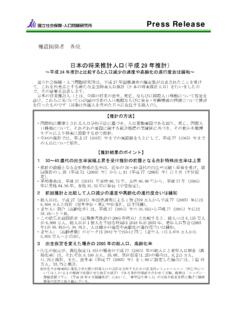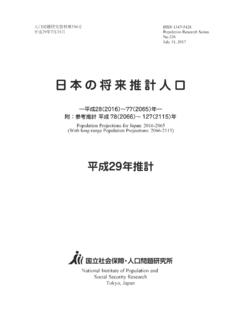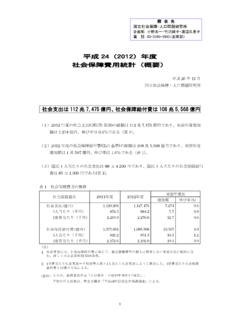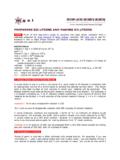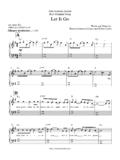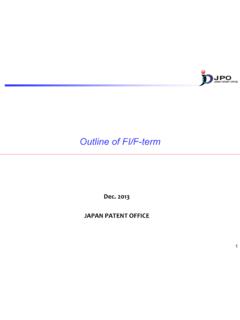Transcription of Population Projections for Japan: 2001-2050
1 Population Projections for japan : 2001-2050 With Long-range Population Projections : 2051 - 2100 January, 2002 National Institute of Population andSocial Security ResearchPopulation Projections for JapanPopulation Projections for japan (January, 2002)The National Institute of Population and Social Security Research officially announced the new future popu-lation Projections for japan . The previous projection , published as Population Projections for japan , Janu-ary 1997, was based on the 1995 Population census, whereas this 12th projection is based on the results ofthe 2000 Population census and the Vital Summary of the Japanese Population Projection1. Trend of the Total PopulationAccording to the 2000 Population census, the base year of this projection , the total Population of japan million. Based on the results of the medium variant projection , the Population is expected to gradu-ally increase in subsequent years, reaching its peak of million in 2006, then enter a longstandingdepopulation process.
2 The Population is expected to drop to the current size by 2013, then decrease to million in 2050 (see Table 1, Figure 1).Based on the results of the high variant projection , the gross Population is expected to reach its peak in 2009at million, a little later than the medium variant projection . A downward turn is expected subse-quently, reaching million in 2050 (see Table 2, Figure 1).Based on the results of the low variant projection , the total Population is expected to reach its peak of in 2004, then subsequently decrease to million in 2050 (see Table 3, Figure 1).These Projections show that japan will soon enter into the era of Population decline, bringing the trend ofpopulation increase to an end. The fact that the fertility rate has been far below the level required to maintainthe stationary Population ( Population replacement level, total fertility rate requires approximately )since the mid-70s, together with the low-fertility rate trend continuing for a quarter-century, make the de- Population which start at the beginning of this century almost Population Trend for Three Major Age Groups(1) Trend of Child Population (aged under 15)The number of births has declined from million in 1973 to million in 2000.
3 Consequently, thepopulation of this age group has decreased from 27 million in the beginning of the 1980s to million inthe Population census of 2000. According to the medium variant projection , the children s Population willdiminish to the 17 million level in 2003 (see Table 1, Figure 3). The decline will continue together with thelow fertility rate trend, and the Population of this age group is expected to fall below 16 million in 2016, thenenter the slow, longstanding depopulation process. Eventually, in the last year of projection (2050), thepopulation is expected to be Projections for JapanAccording to the children s Population trends based on the difference of the future fertility assumptions interms of high and low variant Projections , this age group is expected to be on the decline even in the highvariant projection (due to the longstanding low fertility) and will reach 14 million in 2050 (see Table 2).
4 According to the low variant projection , a rapid decline in Population in this age group due to the very lowfertility rate is expected. The projection is that the Population will diminish from the current size of 18million to below 15 million in 2014, and eventually down to million by the middle of this century (seeTable 3).(2) Trend of Working-age Population (15 to 64)The Population of the working-age group has consistently increased during the post-war years, and reachedits peak in the 1995 census at million. It subsequently entered a decreasing phase, and according to thecensus figures compiled in 2000, the Population has diminished to to the medium variant projection , the Population of this age group reached its peak in 1995,subsequently made an about-turn to enter a declining phase, and is expected to fall below 70 million in 2030,and eventually drop to million in 2050 (see Table 1, Figure 3).
5 According to the working-age Population trend based on the differences on the assumptions of fertility ratein terms of high and low variant Projections , the depopulation of this age group is rather slow due to the highfertility rate, and the Population is expected to fall below 70 million in 2033. The depopulation continuesdown to million in 2050 (see Table 2). The working-age Population based on the low variant projec-tions is expected to fall below 70 million in 2028, below 50 million in 2049, and eventually drop to in 2050 (see Table 3).(3) Trend of Aged Population (aged 65 and over)The results of the medium variant projection show that, contrary to the decline in the populations of thechildren s and working-age groups, the aged group will continue its fast-paced increase, growing from thecurrent size of about 22 million to 30 million in 2013, and eventually up to million in 2018 (see Table1, Figure 3). That is, this age group will grow rapidly until the baby-boom generation (born between 1947and 1949) is in the over-65 age bracket.
6 Subsequently, with the generation that reduced the post-war growthentering the aged group, the speed of increase slows down; the Population will peak in 2043 when thesecond baby-boom generation enters the aged group, then takes a downward turn to about million in2050. The high and low variant Projections show the same result as the medium variant projection , since theassumptions of the future survival rate and international migration are the same (see Table 2, Table 3).3. Trend of the Proportion of Three Major Age Groups(1) Trend of Child Population (aged under 15)The proportion of this group, according to the medium variant projection , is expected to shrink from thecurrent level (2000) to the 14% mark in 2005, and eventually down to in 2021 (see Table 1,Figure 4). The downward trend continues to in 2036, and by 2050, the percentage is expected to bearound high variant projection show that the decline in the proportion of the children s Population is ratherslow, falling below the 14% range in 2007, then down to in decline in the proportion of the children s Population is rapid in the low variant Projections , breakingthe 14% mark in 2004, falling below 10% in 2024, and eventually down to in Projections for japan (2) Trend of Working-age Population (15 to 64)The Population of the working-age group, according to the medium variant projection , started falling in2000 at , and is expected to reduce to in 2020 (see Table 1, Figure 4).
7 The decline continues onslowly to 10 points lower than the current standard in 2035 at , in 2043, and eventually in annual trend of the high variant projection shows similar results, except that the decline trend is slightlyslower. The proportion of this age group in 2050 is only points higher than the medium variant projection ( ).The proportion of this age group for the low variant projection shows a slower reduction as compared withthe medium variant projection - that is, the percentage reaches in 2030. However, the subsequentdecline is fast-paced, reaching in 2050. This seemingly contradictory trend results from the propor-tion of the working-age group being the relative index.(3) Trend of Aged Population (aged 65 and over)The percentage of the aged generation will grow from the current (2000) to the 25% range in 2014,meaning that this age group will comprise one-quarter of the Population of japan .
8 It will reach in2017 (see Table 1, Figure 3). The aged generation will undergo a trend after 2018 until around 2034 when itreaches the 34 million range, continues to increase after 2018 impacted by the low fertility rate, and eventu-ally reaches the 30 plus-percent range in 2033. The increase persists, reaching in 2050; that is, 1 persons will be over variance in the aging trend due to the difference in the assumptions of fertility rate, as compared withthe results of the high and low variant Projections , shows only a minor variance until around 2018. A differ-ence of points is seen between the low variant projection in 2025 ( ) and the high variant projectionduring the same period ( ) (see Table 2, Figure 3). This difference shows the impact that the futurefertility rate has on aging. The difference in the aging level grows wider as the years go by, and in 2050 thehigh variant is , whereas the low variant is , the difference being points.
9 Hence, thelongstanding low fertility rate in society has a relative effect on the aging Population level (see Figure 2).4. Changes in the Population PyramidThe Population pyramid in japan , in general, continues to age. The pyramid appears uneven at the older agebracket, because of the fast-paced fluctuation in the past fertility rates - that is, the rapid increase in thenumber of live birth from 1947 to 1949 (first baby-boom) and the sharp decline in live birth from 1950 to1957 (baby bust) (see Figure 5).The Population pyramid in 2000 consists of the first baby-boomer generation at the beginning of the 50s,and the second baby-boomer generation at the end of the 20s. In the 2025 pyramid, the first baby-boomerswill be at the end of the 70s, and the second baby-boomers at the beginning of the 50s. It can therefore beconcluded that the aging of society toward 2025 is centered on the first baby-boomer generation.
10 On theother hand, the rise in the aging standard around 2050 is the result of interaction of the aging of the secondbaby-boomer generation and the downsizing of the Population per the Population pyramid in japan has transformed from the pre-war shape of Mt. Fuji to the recentshape of a temple bell, and finally to an urn-shape in the Projections for Japan5. Trend of the Population Dependency RatioThe Population dependency ratio is used as an index to express the level of support of the working-agegroup, through comparison of the relative size of the children s and aged populations versus the populationof the working-age group. The old-age dependency ratio (calculated by dividing the aged Population by thepopulation of the working-age group) based on the medium variant projection increases from the current26% (that is, labor forces supporting 1 senior resident) to the 50% range in 2030 (that is, 2 labor forcessupporting 1 senior resident), then eventually up to 67% in 2050 (that is, labor forces supporting 1 seniorresident) (see Table 4).





